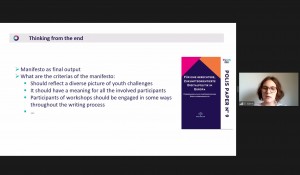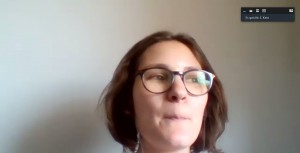How to structure events for meaningful youth participation!
A report on the web seminar by Esther Kern
After the session on ‘How to build a personal connection, even digitally!’, a following training web seminar for #GEOYOUTH2020 took place on June 10, 2020. Esther Kern, a research fellow at the Brandenburg Institute for Society and Security and program lead of The America(n)s at Polis180, gave a presentation on the digital event planning process in order to prepare our Georgian colleagues for a smooth implementation of the Youth Summits. ‘Thinking from the end’ and ‘communication matters’ were two central themes of her interactive web seminar.
Esther kicked-off her talk with the ‘Thinking from the end’ strategy for an output-driven event planning, which essentially requires clear understanding of the final objective. In order to achieve the desired outcome (both the aim of the whole project and of individual events), one should firstly identify and describe criteria of the end-product in details. Once you have this in tangible form, you also know more about HOW to structure individual output-oriented events. With little broad theoretical introduction, Esther moderated a fruitful exchange with the Georgian counterparts about the Youth Manifesto as a final output of the #GEOYOUTH2020 project.
Brainstorming about the Manifesto paved the way for the next step of her ‘Thinking from the end’ method, which is the Manifesto-writing process itself. To come up with a clear, usable, and implementable paper on youth participation, the structure of its writing process should be well organised. In a discussion with the Georgian trainers, Esther increased the awareness on possibilities to engage participants into the follow-up writing process – either by direct contribution or via gaining feedback through an evaluation form, and combining the inputs towards the final product.
Next, the group moved from the writing process towards the summit-planning itself. Esther professionally guided the group-learning process on how to structure individual summits efficiently and on which aspects to focus – challenges that youth are facing OR solutions that can be tackled by target politicians. Furthermore, ample time was given to questions on how to choose those particular topics (pre-selected by trainers or via voting by participants) and how to keep the right balance between giving them enough input and letting them give enough input back.
Last but not least, in order to design and facilitate a digital youth summit well, communication matters! Esther explicitly noted that clear communication before, during, and after the event is of key importance, especially when it comes to young people. In order to increase their confidence, moderators should make sure to deliver all the necessary logistic, contact, and content information in advance, during the summit (including before and after breaks as reminders), and in the form of a wrap-up for follow-up working stages. Crucially, on every step of the process, the participants need to know that their input is valued and that it is a safe place to express their ideas!
Read on: Cristina Bacalso on How to make participatory events meaningful and inclusive!

Esther Kern, Polis180
Project term
01 March- 31 December 2020
Our supporters
The project is funded by the German Federal Foreign Office in the framework of the programme “Expanding Cooperation with Civil Society in the Eastern Partnership Countries and Russia”.





